This article is shared from Huawei cloud community< Keras deep learning Chinese text classification ten thousand word summary (CNN, TextCNN, BiLSTM, attention) >, by eastmount.
I Text classification overview
Text classification aims to automatically classify and mark the text set according to a certain classification system or standard. It belongs to an automatic classification based on the classification system. Text classification can be traced back to the 1950s, when text classification was mainly carried out through expert defined rules; In the 1980s, the expert system established by knowledge engineering appeared; In the 1990s, text classification was carried out through artificial feature engineering and shallow classification model with the help of machine learning method. At present, word vector and deep neural network are mostly used for text classification.
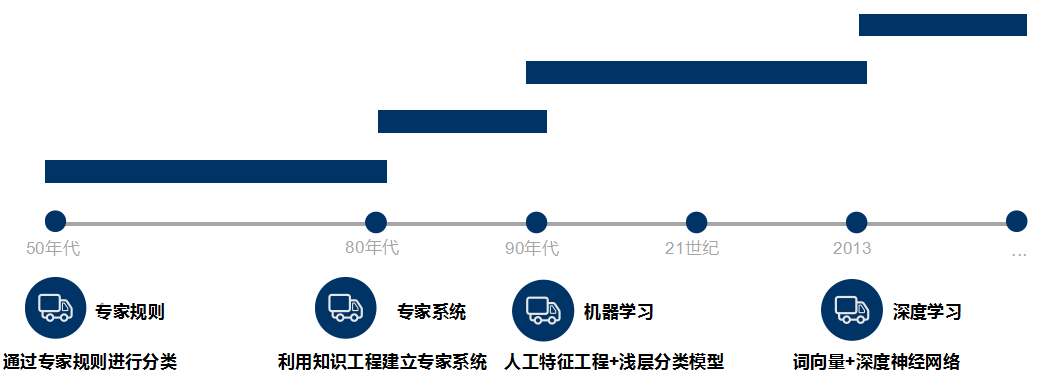
Teacher Niu Yafeng summarized the traditional text classification process as shown in the figure below. In the traditional text classification, most machine learning methods are basically applied in the field of text classification. It mainly includes:
- Naive Bayes
- KNN
- SVM
- Collection class method
- Maximum entropy
- neural network
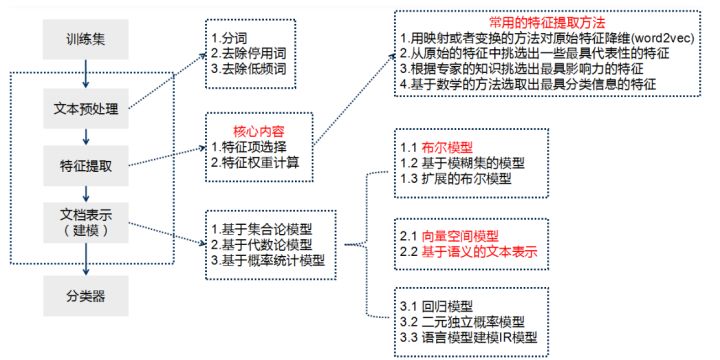
The basic process of text classification using Keras framework is as follows:
- Step 1: text preprocessing, word segmentation - > remove stop words - > statistics, select top n words as feature words
- Step 2: generate ID for each feature word
- Step 3: convert the text into ID sequence and fill the left
- Step 4: training set shuffle
- Step 5: Embedding Layer converts words into word vectors
- Step 6: add the model and construct the neural network structure
- Step 7: Training Model
- Step 8: get the accuracy, recall and F1 value
Note that if TFIDF is used instead of word vector for document representation, the TFIDF matrix is generated after word segmentation and stop, and then the model is input.
Deep learning text classification methods include:
- Convolutional neural network (TextCNN)
- Cyclic neural network (TextRNN)
- TextRNN+Attention
- TextRCNN(TextRNN+CNN)
- BiLSTM+Attention
- Transfer learning
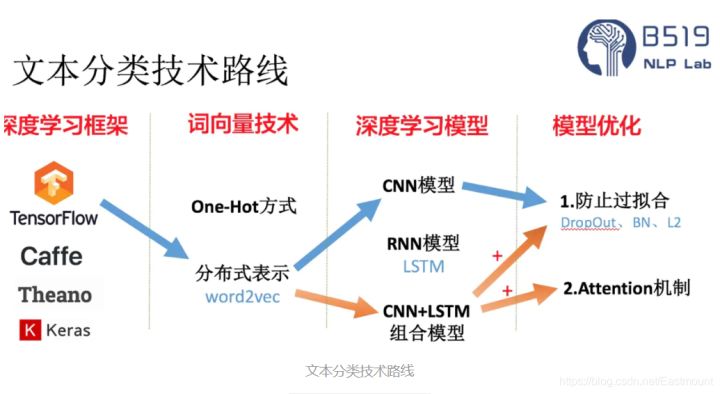
Recommend teacher Niu Yafeng's article:
- Text classification based on word2vec and CNN: Review & Practice
II Data preprocessing and word segmentation
This article mainly focuses on the code, and the algorithm principle knowledge will be supplemented by the previous articles and subsequent articles. The data set is shown in the following figure:
- Training set: news_dataset_train.csv
Game theme (10000), sports theme (10000), cultural theme (10000), financial theme (10000) - Test set: news_dataset_test.csv
Game theme (5000), sports theme (5000), cultural theme (5000), financial theme (5000) - Validation set: news_dataset_val.csv
Game theme (5000), sports theme (5000), cultural theme (5000), financial theme (5000)
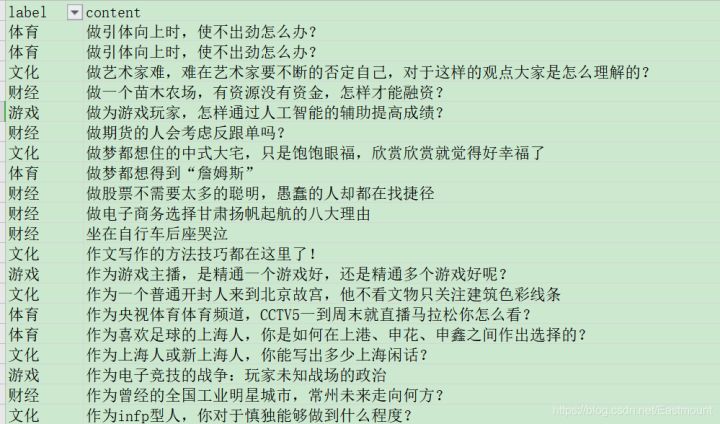
First, we need to preprocess Chinese word segmentation and call Jieba library. The code is as follows:
- data_preprocess.py
# -*- coding:utf-8 -*- # By:Eastmount CSDN 2021-03-19 import csv import pandas as pd import numpy as np import jieba import jieba.analyse #Add custom dictionaries and deactivate Dictionaries jieba.load_userdict("user_dict.txt") stop_list = pd.read_csv('stop_words.txt', engine='python', encoding='utf-8', delimiter="\n", names=['t'])['t'].tolist() #----------------------------------------------------------------------- #Jieba word segmentation function def txt_cut(juzi): return [w for w in jieba.lcut(juzi) if w not in stop_list] #----------------------------------------------------------------------- #Chinese word segmentation reading file def fenci(filename,result): #Write word segmentation results fw = open(result, "w", newline = '',encoding = 'gb18030') writer = csv.writer(fw) writer.writerow(['label','cutword']) #Using CSV Dictreader reads the information in the file labels = [] contents = [] with open(filename, "r", encoding="UTF-8") as f: reader = csv.DictReader(f) for row in reader: #Data element acquisition labels.append(row['label']) content = row['content'] #Chinese word segmentation seglist = txt_cut(content) #Space splicing output = ' '.join(list(seglist)) contents.append(output) #File write tlist = [] tlist.append(row['label']) tlist.append(output) writer.writerow(tlist) print(labels[:5]) print(contents[:5]) fw.close() #----------------------------------------------------------------------- #Main function if __name__ == '__main__': fenci("news_dataset_train.csv", "news_dataset_train_fc.csv") fenci("news_dataset_test.csv", "news_dataset_test_fc.csv") fenci("news_dataset_val.csv", "news_dataset_val_fc.csv")
The operation results are shown in the figure below:
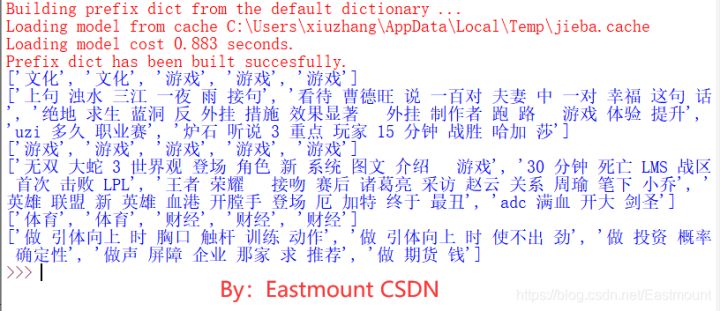
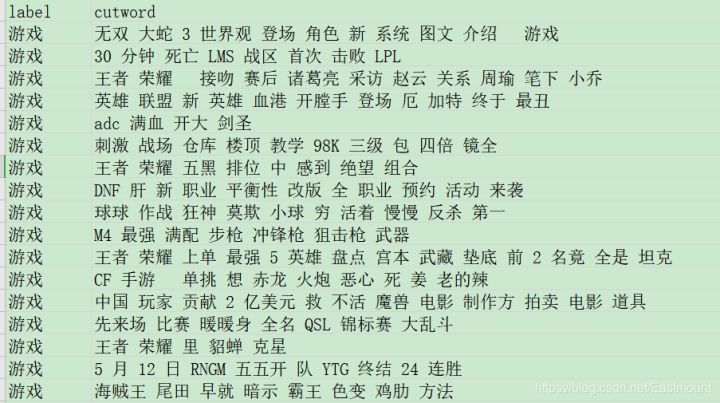
Then we try to simply view the length distribution of data and label visualization.
- data_show.py
# -*- coding: utf-8 -*- """ Created on 2021-03-19 @author: xiuzhang Eastmount CSDN """ import pandas as pd import numpy as np from sklearn import metrics import matplotlib.pyplot as plt import seaborn as sns #---------------------------------------Step 1 data reading------------------------------------ ## Read test data set train_df = pd.read_csv("news_dataset_train_fc.csv") val_df = pd.read_csv("news_dataset_val_fc.csv") test_df = pd.read_csv("news_dataset_test_fc.csv") print(train_df.head()) ## Solve the problem of Chinese display plt.rcParams['font.sans-serif'] = ['KaiTi'] #Specifies the default font SimHei bold plt.rcParams['axes.unicode_minus'] = False #Solution: the saved image is a negative sign' ## See which tags are included in the training set plt.figure() sns.countplot(train_df.label) plt.xlabel('Label',size = 10) plt.xticks(size = 10) plt.show() ## Analyze the distribution of the number of phrases in the training set print(train_df.cutwordnum.describe()) plt.figure() plt.hist(train_df.cutwordnum,bins=100) plt.xlabel("Phrase length", size = 12) plt.ylabel("frequency", size = 12) plt.title("Training data set") plt.show()
The output results are shown in the figure below. In the following article, we will introduce how to draw good-looking charts.
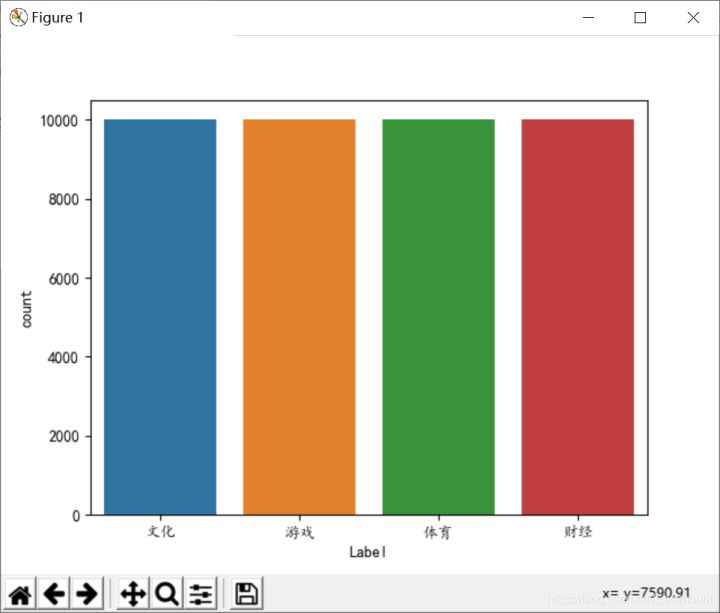
Note that if the error "Unicode decodeerror: 'UTF-8' codec can't decode byte 0xce in position 17: invalid continuation byte" is reported, the CSV file needs to be saved in UTF-8 format, as shown in the following figure.
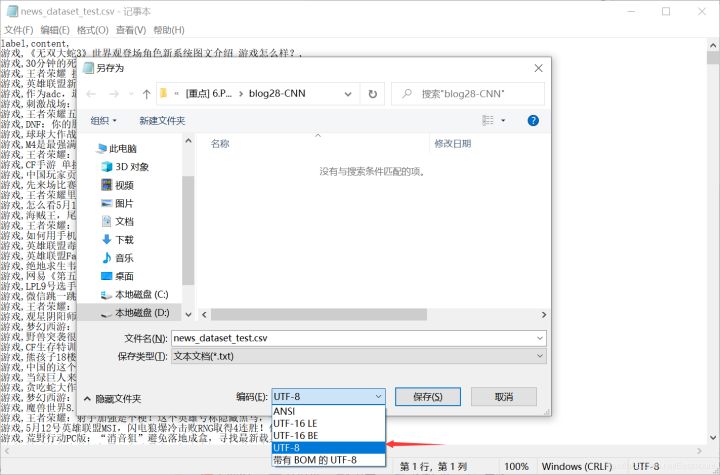
III CNN Chinese text classification
1. Principle introduction
Convolutional neural networks (CNN) is a kind of Feedforward Neural Networks with depth structure including convolution calculation. It is one of the representative algorithms of deep learning. It is usually used in the fields of image recognition and speech recognition, and can give better results. It can also be used in the fields of video analysis, machine translation, natural language processing, drug discovery and so on. The famous alpha dog makes the computer understand that go is based on convolutional neural network.
- Convolution refers to not processing each pixel, but processing the image area. This method strengthens the continuity of the image, sees a graph rather than a point, and also deepens the understanding of the image by the neural network.
- Usually, the convolution neural network will go through the process of "picture - > convolution - > persistence - > convolution - > persistence - > results are transmitted to two fully connected neural layers - > Classifier", and finally realize the classification processing of a CNN.
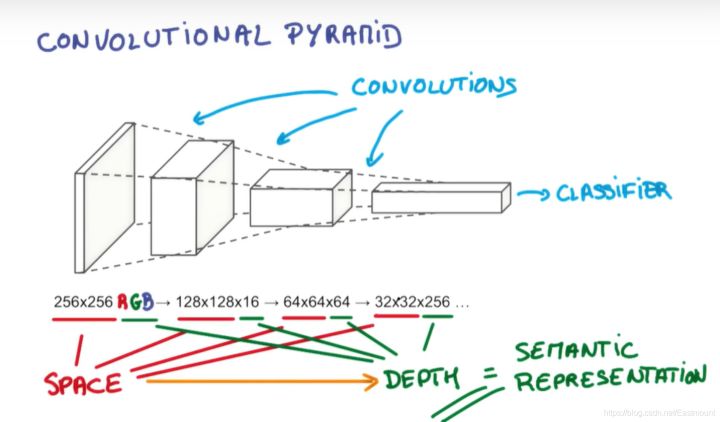
2. Code implementation
The CNN code of Keras for text classification is as follows:
- Keras_CNN_cnews.py
# -*- coding: utf-8 -*- """ Created on 2021-03-19 @author: xiuzhang Eastmount CSDN CNN Model """ import os import time import pickle import pandas as pd import numpy as np from sklearn import metrics import matplotlib.pyplot as plt import seaborn as sns import tensorflow as tf from sklearn.preprocessing import LabelEncoder,OneHotEncoder from keras.models import Model from keras.layers import LSTM, Activation, Dense, Dropout, Input, Embedding from keras.layers import Convolution1D, MaxPool1D, Flatten from keras.preprocessing.text import Tokenizer from keras.preprocessing import sequence from keras.callbacks import EarlyStopping from keras.models import load_model from keras.models import Sequential ## If the GPU processing reader is a CPU, you can comment on this part of the code ## Specifies the maximum amount of video memory used in each GPU process 0.9 Indicates that it can be used GPU 90%Training with resources os.environ["CUDA_DEVICES_ORDER"] = "PCI_BUS_IS" os.environ["CUDA_VISIBLE_DEVICES"] = "0" gpu_options = tf.GPUOptions(per_process_gpu_memory_fraction=0.8) sess = tf.Session(config=tf.ConfigProto(gpu_options=gpu_options)) start = time.clock() #----------------------------Step 1 data reading---------------------------- ## Read test data set train_df = pd.read_csv("news_dataset_train_fc.csv") val_df = pd.read_csv("news_dataset_val_fc.csv") test_df = pd.read_csv("news_dataset_test_fc.csv") print(train_df.head()) ## Solve the problem of Chinese display plt.rcParams['font.sans-serif'] = ['KaiTi'] #Specifies the default font SimHei bold plt.rcParams['axes.unicode_minus'] = False #Solution: the saved image is a negative sign' #--------------------------Step 2 OneHotEncoder()code-------------------- ## Encode the label data of the dataset train_y = train_df.label val_y = val_df.label test_y = test_df.label print("Label:") print(train_y[:10]) le = LabelEncoder() train_y = le.fit_transform(train_y).reshape(-1,1) val_y = le.transform(val_y).reshape(-1,1) test_y = le.transform(test_y).reshape(-1,1) print("LabelEncoder") print(train_y[:10]) print(len(train_y)) ## Label data of the dataset-hot code ohe = OneHotEncoder() train_y = ohe.fit_transform(train_y).toarray() val_y = ohe.transform(val_y).toarray() test_y = ohe.transform(test_y).toarray() print("OneHotEncoder:") print(train_y[:10]) #-----------------------Step 3 use Tokenizer Encode phrases-------------------- max_words = 6000 max_len = 600 tok = Tokenizer(num_words=max_words) #The maximum number of words is 6000 print(train_df.cutword[:5]) print(type(train_df.cutword)) ## Prevent digital str processing in Corpus train_content = [str(a) for a in train_df.cutword.tolist()] val_content = [str(a) for a in val_df.cutword.tolist()] test_content = [str(a) for a in test_df.cutword.tolist()] tok.fit_on_texts(train_content) print(tok) #Use fit after the Tokenizer object is created_ on_ The texts () function recognizes each word #tok.fit_on_texts(train_df.cutword) ## Save the trained Tokenizer and import with open('tok.pickle', 'wb') as handle: #saving pickle.dump(tok, handle, protocol=pickle.HIGHEST_PROTOCOL) with open('tok.pickle', 'rb') as handle: #loading tok = pickle.load(handle) ## Using word_ The index attribute looks at the code corresponding to each word ## Using word_ Count property to view the frequency corresponding to each word for ii,iterm in enumerate(tok.word_index.items()): if ii < 10: print(iterm) else: break print("===================") for ii,iterm in enumerate(tok.word_counts.items()): if ii < 10: print(iterm) else: break #---------------------------Step 4 convert data into sequence----------------------------- ## Use sequence pad_ Sequences () adjusts each sequence to the same length ## After coding each word, each word in each news sentence can be represented by the corresponding coding, that is, each news can be transformed into a vector train_seq = tok.texts_to_sequences(train_content) val_seq = tok.texts_to_sequences(val_content) test_seq = tok.texts_to_sequences(test_content) ## Adjust each sequence to the same length train_seq_mat = sequence.pad_sequences(train_seq,maxlen=max_len) val_seq_mat = sequence.pad_sequences(val_seq,maxlen=max_len) test_seq_mat = sequence.pad_sequences(test_seq,maxlen=max_len) print("Data conversion sequence") print(train_seq_mat.shape) print(val_seq_mat.shape) print(test_seq_mat.shape) print(train_seq_mat[:2]) #-------------------------------Step 5 establish CNN Model-------------------------- ## 4 categories num_labels = 4 inputs = Input(name='inputs',shape=[max_len], dtype='float64') ## Word embedding uses pre trained word vectors layer = Embedding(max_words+1, 128, input_length=max_len, trainable=False)(inputs) ## Convolution layer and pooling layer (word window size is 3 128 cores) cnn = Convolution1D(128, 3, padding='same', strides = 1, activation='relu')(layer) cnn = MaxPool1D(pool_size=4)(cnn) ## Dropout prevents overfitting flat = Flatten()(cnn) drop = Dropout(0.3)(flat) ## Full connection layer main_output = Dense(num_labels, activation='softmax')(drop) model = Model(inputs=inputs, outputs=main_output) ## Optimization function evaluation index model.summary() model.compile(loss="categorical_crossentropy", optimizer='adam', # RMSprop() metrics=["accuracy"]) #-------------------------------Step 6 model training and prediction-------------------------- ## First set to train training and then set to test test flag = "train" if flag == "train": print("model training") ## Model training-loss Stop training when you no longer improve 0.0001 model_fit = model.fit(train_seq_mat, train_y, batch_size=128, epochs=10, validation_data=(val_seq_mat,val_y), callbacks=[EarlyStopping(monitor='val_loss',min_delta=0.0001)] ) ## Save model model.save('my_model.h5') del model # deletes the existing model ## computing time elapsed = (time.clock() - start) print("Time used:", elapsed) print(model_fit.history) else: print("model prediction ") ## Import the trained model model = load_model('my_model.h5') ## Predict the test set test_pre = model.predict(test_seq_mat) ## Evaluate the prediction effect and calculate the confusion matrix confm = metrics.confusion_matrix(np.argmax(test_y,axis=1),np.argmax(test_pre,axis=1)) print(confm) ## Confusion matrix visualization Labname = ["Sports", "Culture", "Finance and Economics", "game"] print(metrics.classification_report(np.argmax(test_y,axis=1),np.argmax(test_pre,axis=1))) plt.figure(figsize=(8,8)) sns.heatmap(confm.T, square=True, annot=True, fmt='d', cbar=False, linewidths=.6, cmap="YlGnBu") plt.xlabel('True label',size = 14) plt.ylabel('Predicted label', size = 14) plt.xticks(np.arange(4)+0.5, Labname, size = 12) plt.yticks(np.arange(4)+0.5, Labname, size = 12) plt.savefig('result.png') plt.show() #----------------------------------Seventh, verify the algorithm-------------------------- ## tok is used to preprocess the validation data set, and the trained model is used for prediction val_seq = tok.texts_to_sequences(val_df.cutword) ## Adjust each sequence to the same length val_seq_mat = sequence.pad_sequences(val_seq,maxlen=max_len) ## Predict validation set val_pre = model.predict(val_seq_mat) print(metrics.classification_report(np.argmax(val_y,axis=1),np.argmax(val_pre,axis=1))) ## computing time elapsed = (time.clock() - start) print("Time used:", elapsed)
GPU operation is shown in the figure below. Note that if your computer is a CPU version, you only need to comment out the first part of the above code, and the later LSTM part uses the library function corresponding to GPU.

The training output model is shown in the figure below:
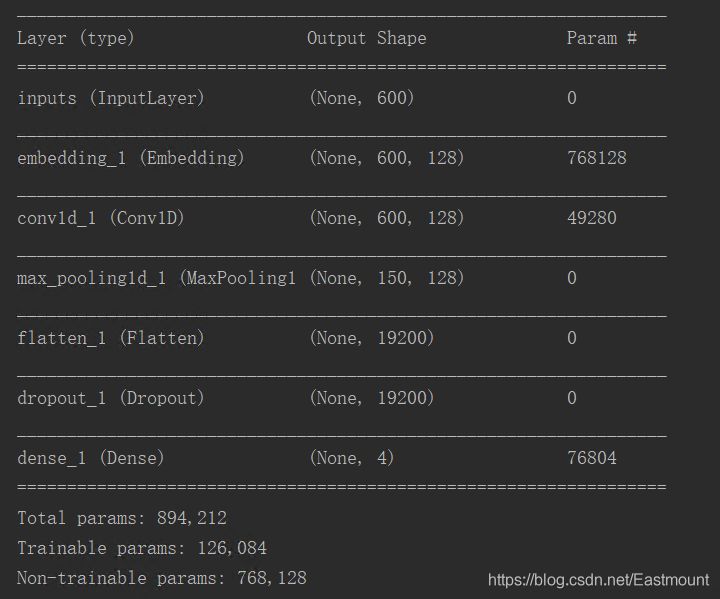
The training output results are as follows:
model training Train on 40000 samples, validate on 20000 samples Epoch 1/10 40000/40000 [==============================] - 15s 371us/step - loss: 1.1798 - acc: 0.4772 - val_loss: 0.9878 - val_acc: 0.5977 Epoch 2/10 40000/40000 [==============================] - 4s 93us/step - loss: 0.8681 - acc: 0.6612 - val_loss: 0.8167 - val_acc: 0.6746 Epoch 3/10 40000/40000 [==============================] - 4s 92us/step - loss: 0.7268 - acc: 0.7245 - val_loss: 0.7084 - val_acc: 0.7330 Epoch 4/10 40000/40000 [==============================] - 4s 93us/step - loss: 0.6369 - acc: 0.7643 - val_loss: 0.6462 - val_acc: 0.7617 Epoch 5/10 40000/40000 [==============================] - 4s 96us/step - loss: 0.5670 - acc: 0.7957 - val_loss: 0.5895 - val_acc: 0.7867 Epoch 6/10 40000/40000 [==============================] - 4s 92us/step - loss: 0.5074 - acc: 0.8226 - val_loss: 0.5530 - val_acc: 0.8018 Epoch 7/10 40000/40000 [==============================] - 4s 93us/step - loss: 0.4638 - acc: 0.8388 - val_loss: 0.5105 - val_acc: 0.8185 Epoch 8/10 40000/40000 [==============================] - 4s 93us/step - loss: 0.4241 - acc: 0.8545 - val_loss: 0.4836 - val_acc: 0.8304 Epoch 9/10 40000/40000 [==============================] - 4s 92us/step - loss: 0.3900 - acc: 0.8692 - val_loss: 0.4599 - val_acc: 0.8403 Epoch 10/10 40000/40000 [==============================] - 4s 93us/step - loss: 0.3657 - acc: 0.8761 - val_loss: 0.4472 - val_acc: 0.8457 Time used: 52.203992899999996
The prediction and verification results are as follows:
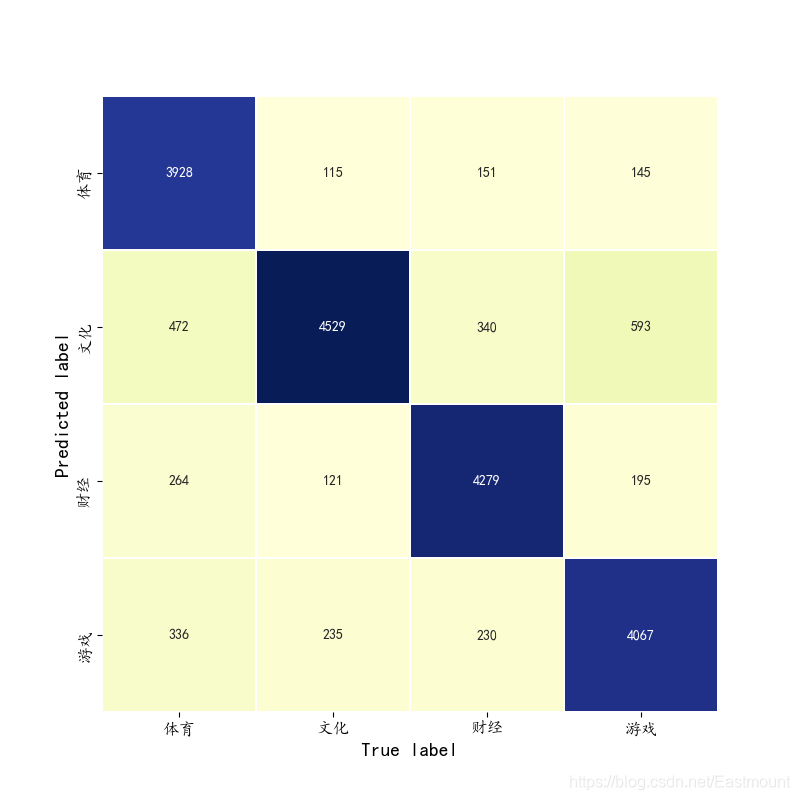
[[3928 472 264 336] [ 115 4529 121 235] [ 151 340 4279 230] [ 145 593 195 4067]] precision recall f1-score support 0 0.91 0.79 0.84 5000 1 0.76 0.91 0.83 5000 2 0.88 0.86 0.87 5000 3 0.84 0.81 0.82 5000 avg / total 0.85 0.84 0.84 20000 precision recall f1-score support 0 0.90 0.77 0.83 5000 1 0.78 0.92 0.84 5000 2 0.88 0.85 0.86 5000 3 0.84 0.85 0.85 5000 avg / total 0.85 0.85 0.85 20000
IV TextCNN Chinese text classification
1. Principle introduction
TextCNN is an algorithm for text classification using convolutional neural network, which was proposed by Yoon Kim in the article "revolutionary neural networks for sense classification" in 2014.
The core idea of convolutional neural network is to capture local features. For text, local features are sliding windows composed of several words, similar to N-gram. The advantage of convolutional neural network is that it can automatically combine and screen N-gram features to obtain semantic information at different levels of abstraction. The following figure is the convolution neural network model architecture used for text classification in this paper.
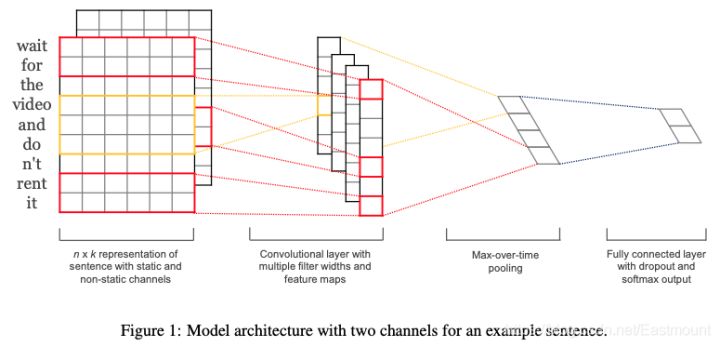
Another classic paper of TextCNN is A Sensitivity Analysis of (and Practitioners' Guide to) revolutionary neural networks for sensitivity classification. The model results are shown in the figure below. TextCNN structure description, which is mainly used for text classification task, explains in detail how TextCNN architecture and word vector matrix convolute.
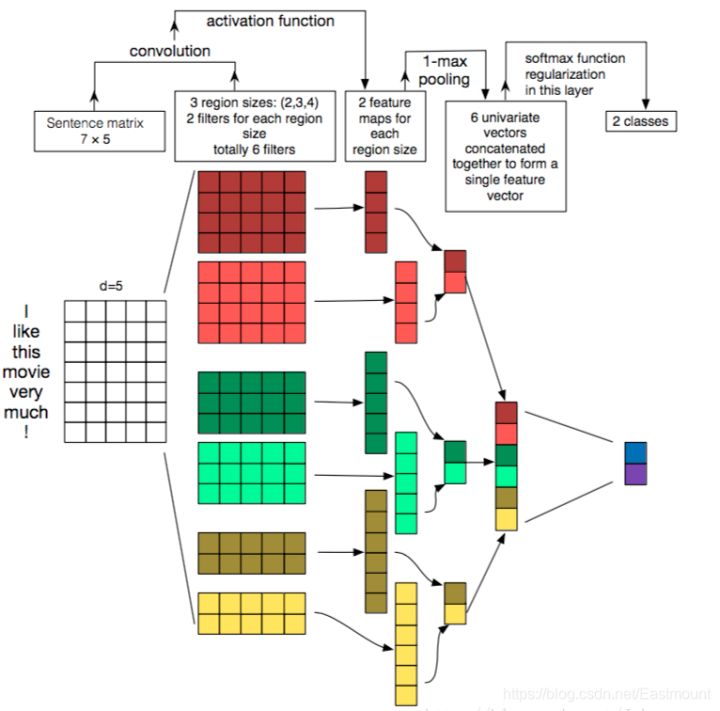
Suppose we have some sentences that need to be classified. Each word in the sentence is composed of an n-dimensional word vector, that is, the size of the input matrix is m*n, where m is the length of the sentence. CNN needs to convolute the input samples. For text data, the filter no longer slides horizontally, but only moves downward, which is somewhat similar to N-gram in extracting the local correlation between words.
There are three step strategies in the figure, namely 2, 3 and 4. Each step has two filters (there will be a large number of filters during actual training). Using different filters on different word windows, six convoluted vectors are finally obtained. Then, each vector is maximized and pooled, and each pooled value is spliced. Finally, the feature representation of the sentence is obtained. The sentence vector is thrown to the classifier for classification, and finally the whole text classification process is completed.
Finally, I sincerely recommend the following leaders' introduction to TextCNN, especially the Asia Lee boss of CSDN. I like his article very much. It's really great!
- <Convolutional Neural Networks for Sentence Classification2014>
- <A Sensitivity Analysis of (and Practitioners' Guide to) Convolutional Neural Networks for Sentence Classification>
- https://blog.csdn.net/asialee_bird/article/details/88813385
- https://zhuanlan.zhihu.com/p/77634533
2. Code implementation
The TextCNN code used by Keras to realize text classification is as follows:
- Keras_TextCNN_cnews.py
# -*- coding: utf-8 -*- """ Created on 2021-03-19 @author: xiuzhang Eastmount CSDN TextCNN Model """ import os import time import pickle import pandas as pd import numpy as np from sklearn import metrics import matplotlib.pyplot as plt import seaborn as sns import tensorflow as tf from sklearn.preprocessing import LabelEncoder,OneHotEncoder from keras.models import Model from keras.layers import LSTM, Activation, Dense, Dropout, Input, Embedding from keras.layers import Convolution1D, MaxPool1D, Flatten from keras.preprocessing.text import Tokenizer from keras.preprocessing import sequence from keras.callbacks import EarlyStopping from keras.models import load_model from keras.models import Sequential from keras.layers.merge import concatenate ## If the GPU processing reader is a CPU, you can comment on this part of the code ## Specifies the maximum amount of video memory used in each GPU process 0.9 Indicates that it can be used GPU 90%Training with resources os.environ["CUDA_DEVICES_ORDER"] = "PCI_BUS_IS" os.environ["CUDA_VISIBLE_DEVICES"] = "0" gpu_options = tf.GPUOptions(per_process_gpu_memory_fraction=0.8) sess = tf.Session(config=tf.ConfigProto(gpu_options=gpu_options)) start = time.clock() #----------------------------Step 1 data reading---------------------------- ## Read test data set train_df = pd.read_csv("news_dataset_train_fc.csv") val_df = pd.read_csv("news_dataset_val_fc.csv") test_df = pd.read_csv("news_dataset_test_fc.csv") ## Solve the problem of Chinese display plt.rcParams['font.sans-serif'] = ['KaiTi'] #Specifies the default font SimHei bold plt.rcParams['axes.unicode_minus'] = False #Solution: the saved image is a negative sign' #--------------------------Step 2 OneHotEncoder()code-------------------- ## Encode the label data of the dataset train_y = train_df.label val_y = val_df.label test_y = test_df.label print("Label:") print(train_y[:10]) le = LabelEncoder() train_y = le.fit_transform(train_y).reshape(-1,1) val_y = le.transform(val_y).reshape(-1,1) test_y = le.transform(test_y).reshape(-1,1) print("LabelEncoder") print(train_y[:10]) print(len(train_y)) ## Label data of the dataset-hot code ohe = OneHotEncoder() train_y = ohe.fit_transform(train_y).toarray() val_y = ohe.transform(val_y).toarray() test_y = ohe.transform(test_y).toarray() print("OneHotEncoder:") print(train_y[:10]) #-----------------------Step 3 use Tokenizer Encode phrases-------------------- max_words = 6000 max_len = 600 tok = Tokenizer(num_words=max_words) #The maximum number of words is 6000 print(train_df.cutword[:5]) print(type(train_df.cutword)) ## Prevent digital str processing in Corpus train_content = [str(a) for a in train_df.cutword.tolist()] val_content = [str(a) for a in val_df.cutword.tolist()] test_content = [str(a) for a in test_df.cutword.tolist()] tok.fit_on_texts(train_content) print(tok) ## Save the trained Tokenizer and import with open('tok.pickle', 'wb') as handle: #saving pickle.dump(tok, handle, protocol=pickle.HIGHEST_PROTOCOL) with open('tok.pickle', 'rb') as handle: #loading tok = pickle.load(handle) #---------------------------Step 4 convert data into sequence----------------------------- train_seq = tok.texts_to_sequences(train_content) val_seq = tok.texts_to_sequences(val_content) test_seq = tok.texts_to_sequences(test_content) ## Adjust each sequence to the same length train_seq_mat = sequence.pad_sequences(train_seq,maxlen=max_len) val_seq_mat = sequence.pad_sequences(val_seq,maxlen=max_len) test_seq_mat = sequence.pad_sequences(test_seq,maxlen=max_len) print("Data conversion sequence") print(train_seq_mat.shape) print(val_seq_mat.shape) print(test_seq_mat.shape) print(train_seq_mat[:2]) #-------------------------------Step 5 establish TextCNN Model-------------------------- ## 4 categories num_labels = 4 inputs = Input(name='inputs',shape=[max_len], dtype='float64') ## Word embedding uses pre trained word vectors layer = Embedding(max_words+1, 256, input_length=max_len, trainable=False)(inputs) ## The word window size is 3 respectively,4,5 cnn1 = Convolution1D(256, 3, padding='same', strides = 1, activation='relu')(layer) cnn1 = MaxPool1D(pool_size=4)(cnn1) cnn2 = Convolution1D(256, 4, padding='same', strides = 1, activation='relu')(layer) cnn2 = MaxPool1D(pool_size=4)(cnn2) cnn3 = Convolution1D(256, 5, padding='same', strides = 1, activation='relu')(layer) cnn3 = MaxPool1D(pool_size=4)(cnn3) # Merge the output vectors of the three models cnn = concatenate([cnn1,cnn2,cnn3], axis=-1) flat = Flatten()(cnn) drop = Dropout(0.2)(flat) main_output = Dense(num_labels, activation='softmax')(drop) model = Model(inputs=inputs, outputs=main_output) model.summary() model.compile(loss="categorical_crossentropy", optimizer='adam', # RMSprop() metrics=["accuracy"]) #-------------------------------Step 6 model training and prediction-------------------------- ## First set to train training and then set to test test flag = "train" if flag == "train": print("model training") ## Model training-loss Stop training when you no longer improve 0.0001 model_fit = model.fit(train_seq_mat, train_y, batch_size=128, epochs=10, validation_data=(val_seq_mat,val_y), callbacks=[EarlyStopping(monitor='val_loss',min_delta=0.0001)] ) model.save('my_model.h5') del model elapsed = (time.clock() - start) print("Time used:", elapsed) print(model_fit.history) else: print("model prediction ") ## Import the trained model model = load_model('my_model.h5') ## Predict the test set test_pre = model.predict(test_seq_mat) ## Evaluate the prediction effect and calculate the confusion matrix confm = metrics.confusion_matrix(np.argmax(test_y,axis=1),np.argmax(test_pre,axis=1)) print(confm) ## Confusion matrix visualization Labname = ["Sports", "Culture", "Finance and Economics", "game"] print(metrics.classification_report(np.argmax(test_y,axis=1),np.argmax(test_pre,axis=1))) plt.figure(figsize=(8,8)) sns.heatmap(confm.T, square=True, annot=True, fmt='d', cbar=False, linewidths=.6, cmap="YlGnBu") plt.xlabel('True label',size = 14) plt.ylabel('Predicted label', size = 14) plt.xticks(np.arange(4)+0.5, Labname, size = 12) plt.yticks(np.arange(4)+0.5, Labname, size = 12) plt.savefig('result.png') plt.show() #----------------------------------Seventh, verify the algorithm-------------------------- ## tok is used to preprocess the validation data set, and the trained model is used for prediction val_seq = tok.texts_to_sequences(val_df.cutword) ## Adjust each sequence to the same length val_seq_mat = sequence.pad_sequences(val_seq,maxlen=max_len) ## Predict validation set val_pre = model.predict(val_seq_mat) print(metrics.classification_report(np.argmax(val_y,axis=1),np.argmax(val_pre,axis=1))) elapsed = (time.clock() - start) print("Time used:", elapsed)
The training model is as follows:
__________________________________________________________________________________________________ Layer (type) Output Shape Param # Connected to ================================================================================================== inputs (InputLayer) (None, 600) 0 __________________________________________________________________________________________________ embedding_1 (Embedding) (None, 600, 256) 1536256 inputs[0][0] __________________________________________________________________________________________________ conv1d_1 (Conv1D) (None, 600, 256) 196864 embedding_1[0][0] __________________________________________________________________________________________________ conv1d_2 (Conv1D) (None, 600, 256) 262400 embedding_1[0][0] __________________________________________________________________________________________________ conv1d_3 (Conv1D) (None, 600, 256) 327936 embedding_1[0][0] __________________________________________________________________________________________________ max_pooling1d_1 (MaxPooling1D) (None, 150, 256) 0 conv1d_1[0][0] __________________________________________________________________________________________________ max_pooling1d_2 (MaxPooling1D) (None, 150, 256) 0 conv1d_2[0][0] __________________________________________________________________________________________________ max_pooling1d_3 (MaxPooling1D) (None, 150, 256) 0 conv1d_3[0][0] __________________________________________________________________________________________________ concatenate_1 (Concatenate) (None, 150, 768) 0 max_pooling1d_1[0][0] max_pooling1d_2[0][0] max_pooling1d_3[0][0] __________________________________________________________________________________________________ flatten_1 (Flatten) (None, 115200) 0 concatenate_1[0][0] __________________________________________________________________________________________________ dropout_1 (Dropout) (None, 115200) 0 flatten_1[0][0] __________________________________________________________________________________________________ dense_1 (Dense) (None, 4) 460804 dropout_1[0][0] ================================================================================================== Total params: 2,784,260 Trainable params: 1,248,004 Non-trainable params: 1,536,256 __________________________________________________________________________________________________
The predicted results are as follows:

[[4448 238 182 132] [ 151 4572 124 153] [ 185 176 4545 94] [ 181 394 207 4218]] precision recall f1-score support 0 0.90 0.89 0.89 5000 1 0.85 0.91 0.88 5000 2 0.90 0.91 0.90 5000 3 0.92 0.84 0.88 5000 avg / total 0.89 0.89 0.89 20000 precision recall f1-score support 0 0.90 0.88 0.89 5000 1 0.86 0.93 0.89 5000 2 0.91 0.89 0.90 5000 3 0.92 0.88 0.90 5000 avg / total 0.90 0.90 0.90 20000
V LSTM Chinese text classification
1. Principle introduction
Long Short Term network (LSTM) is a special type of RNN (Recurrent Neural Network), which can learn long-term dependence information. LSTM was proposed by Hochreiter & schmidhuber (1997) and recently improved and popularized by Alex Graves. In many problems, LSTM has achieved considerable success and has been widely used.
Because RNN has the problem of gradient disappearance, people have improved the hidden structure of sequence index position t. some techniques are used to make the hidden structure complex to avoid the problem of gradient disappearance. Such a special RNN is our LSTM. The full name of LSTM is long short term memory. Because of its design characteristics, LSTM is very suitable for modeling time series data, such as text data. The structure of LSTM is shown in the figure below:
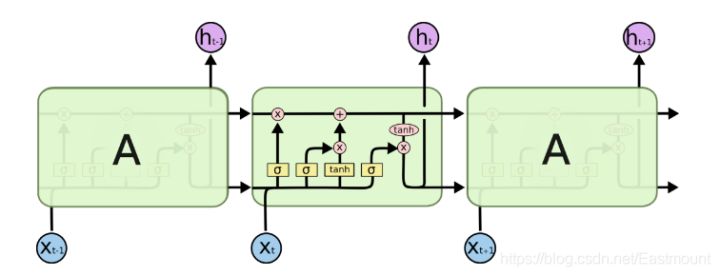
LSTM is deliberately designed to avoid long-term dependency problems. Remember that long-term information is the default behavior of LSTM in practice, not the ability to obtain it at a great cost. LSTM has made some improvements on the ordinary RNN. LSTM RNN has three more controllers, namely:
- Input controller
- Output controller
- Forget controller
There are more mainlines on the left, such as the main plot of the film, while the original RNN system has become a branch plot, and the three controllers are on the branch.
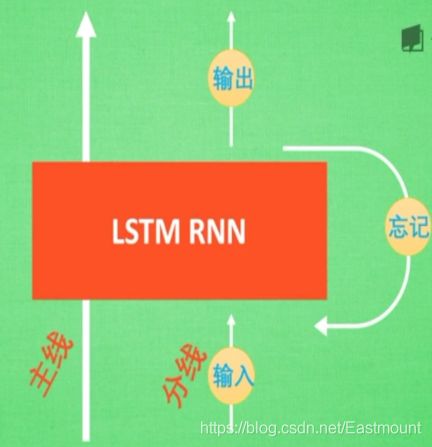
- Input controller (write gate): set a gate when inputting input. The function of gate is to judge whether to write this input into our Memory. It is equivalent to a parameter and can be trained. This parameter is used to control whether to remember the current point.
- Output controller (read gate): in the gate of the output position, judge whether to read the current Memory.
- Forget gate: the forget gate of the processing position to determine whether to forget the previous Memory.
The working principle of LSTM is: if the branch content is very important for the final result, the input controller will write the branch content into the main line content according to the importance, and then analyze it; If the branching content changes our previous idea, the forgetting controller will forget some mainline content and replace the new content proportionally, so the update of mainline content depends on input and forgetting control; The final output will be based on the main line content and branch line content. Through these three gate s, we can well control our RNN. Based on these control mechanisms, LSTM is a good medicine to delay memory, so as to bring better results.
2. Code implementation
The LSTM code of text classification implemented by Keras is as follows:
- Keras_LSTM_cnews.py
""" Created on 2021-03-19 @author: xiuzhang Eastmount CSDN LSTM Model """ import os import time import pickle import pandas as pd import numpy as np from sklearn import metrics import matplotlib.pyplot as plt import seaborn as sns import tensorflow as tf from sklearn.preprocessing import LabelEncoder,OneHotEncoder from keras.models import Model from keras.layers import LSTM, Activation, Dense, Dropout, Input, Embedding from keras.layers import Convolution1D, MaxPool1D, Flatten from keras.preprocessing.text import Tokenizer from keras.preprocessing import sequence from keras.callbacks import EarlyStopping from keras.models import load_model from keras.models import Sequential #GPU accelerates CuDNNLSTM faster than LSTM from keras.layers import CuDNNLSTM, CuDNNGRU ## If the GPU processing reader is a CPU, you can comment on this part of the code ## Specifies the maximum amount of video memory used in each GPU process 0.9 Indicates that it can be used GPU 90%Training with resources os.environ["CUDA_DEVICES_ORDER"] = "PCI_BUS_IS" os.environ["CUDA_VISIBLE_DEVICES"] = "0" gpu_options = tf.GPUOptions(per_process_gpu_memory_fraction=0.8) sess = tf.Session(config=tf.ConfigProto(gpu_options=gpu_options)) start = time.clock() #----------------------------Step 1 data reading---------------------------- ## Read test data set train_df = pd.read_csv("news_dataset_train_fc.csv") val_df = pd.read_csv("news_dataset_val_fc.csv") test_df = pd.read_csv("news_dataset_test_fc.csv") print(train_df.head()) ## Solve the problem of Chinese display plt.rcParams['font.sans-serif'] = ['KaiTi'] #Specifies the default font SimHei bold plt.rcParams['axes.unicode_minus'] = False #Solution: the saved image is a negative sign' #--------------------------Step 2 OneHotEncoder()code-------------------- ## Encode the label data of the dataset train_y = train_df.label val_y = val_df.label test_y = test_df.label print("Label:") print(train_y[:10]) le = LabelEncoder() train_y = le.fit_transform(train_y).reshape(-1,1) val_y = le.transform(val_y).reshape(-1,1) test_y = le.transform(test_y).reshape(-1,1) print("LabelEncoder") print(train_y[:10]) print(len(train_y)) ## Label data of the dataset-hot code ohe = OneHotEncoder() train_y = ohe.fit_transform(train_y).toarray() val_y = ohe.transform(val_y).toarray() test_y = ohe.transform(test_y).toarray() print("OneHotEncoder:") print(train_y[:10]) #-----------------------Step 3 use Tokenizer Encode phrases-------------------- max_words = 6000 max_len = 600 tok = Tokenizer(num_words=max_words) #The maximum number of words is 6000 print(train_df.cutword[:5]) print(type(train_df.cutword)) ## Prevent digital str processing in Corpus train_content = [str(a) for a in train_df.cutword.tolist()] val_content = [str(a) for a in val_df.cutword.tolist()] test_content = [str(a) for a in test_df.cutword.tolist()] tok.fit_on_texts(train_content) print(tok) ## Save the trained Tokenizer and import with open('tok.pickle', 'wb') as handle: #saving pickle.dump(tok, handle, protocol=pickle.HIGHEST_PROTOCOL) with open('tok.pickle', 'rb') as handle: #loading tok = pickle.load(handle) #---------------------------Step 4 convert data into sequence----------------------------- train_seq = tok.texts_to_sequences(train_content) val_seq = tok.texts_to_sequences(val_content) test_seq = tok.texts_to_sequences(test_content) ## Adjust each sequence to the same length train_seq_mat = sequence.pad_sequences(train_seq,maxlen=max_len) val_seq_mat = sequence.pad_sequences(val_seq,maxlen=max_len) test_seq_mat = sequence.pad_sequences(test_seq,maxlen=max_len) print("Data conversion sequence") print(train_seq_mat.shape) print(val_seq_mat.shape) print(test_seq_mat.shape) print(train_seq_mat[:2]) #-------------------------------Step 5 establish LSTM Model-------------------------- ## Define LSTM model inputs = Input(name='inputs',shape=[max_len],dtype='float64') ## Embedding (vocabulary size, batch size, word length of each news) layer = Embedding(max_words+1, 128, input_length=max_len)(inputs) #layer = LSTM(128)(layer) layer = CuDNNLSTM(128)(layer) layer = Dense(128, activation="relu", name="FC1")(layer) layer = Dropout(0.1)(layer) layer = Dense(4, activation="softmax", name="FC2")(layer) model = Model(inputs=inputs, outputs=layer) model.summary() model.compile(loss="categorical_crossentropy", optimizer='adam', # RMSprop() metrics=["accuracy"]) #-------------------------------Step 6 model training and prediction-------------------------- ## First set to train training and then set to test test flag = "train" if flag == "train": print("model training") ## Model training-loss Stop training when you no longer improve 0.0001 model_fit = model.fit(train_seq_mat, train_y, batch_size=128, epochs=10, validation_data=(val_seq_mat,val_y), callbacks=[EarlyStopping(monitor='val_loss',min_delta=0.0001)] ) model.save('my_model.h5') del model elapsed = (time.clock() - start) print("Time used:", elapsed) print(model_fit.history) else: print("model prediction ") ## Import the trained model model = load_model('my_model.h5') ## Predict the test set test_pre = model.predict(test_seq_mat) ## Evaluate the prediction effect and calculate the confusion matrix confm = metrics.confusion_matrix(np.argmax(test_y,axis=1),np.argmax(test_pre,axis=1)) print(confm) ## Confusion matrix visualization Labname = ["Sports", "Culture", "Finance and Economics", "game"] print(metrics.classification_report(np.argmax(test_y,axis=1),np.argmax(test_pre,axis=1))) plt.figure(figsize=(8,8)) sns.heatmap(confm.T, square=True, annot=True, fmt='d', cbar=False, linewidths=.6, cmap="YlGnBu") plt.xlabel('True label',size = 14) plt.ylabel('Predicted label', size = 14) plt.xticks(np.arange(4)+0.8, Labname, size = 12) plt.yticks(np.arange(4)+0.4, Labname, size = 12) plt.savefig('result.png') plt.show() #----------------------------------Seventh, verify the algorithm-------------------------- ## tok is used to preprocess the validation data set, and the trained model is used for prediction val_seq = tok.texts_to_sequences(val_df.cutword) ## Adjust each sequence to the same length val_seq_mat = sequence.pad_sequences(val_seq,maxlen=max_len) ## Predict validation set val_pre = model.predict(val_seq_mat) print(metrics.classification_report(np.argmax(val_y,axis=1),np.argmax(val_pre,axis=1))) elapsed = (time.clock() - start) print("Time used:", elapsed)
The training output model is as follows:
_________________________________________________________________ Layer (type) Output Shape Param # ================================================================= inputs (InputLayer) (None, 600) 0 _________________________________________________________________ embedding_1 (Embedding) (None, 600, 128) 768128 _________________________________________________________________ cu_dnnlstm_1 (CuDNNLSTM) (None, 128) 132096 _________________________________________________________________ FC1 (Dense) (None, 128) 16512 _________________________________________________________________ dropout_1 (Dropout) (None, 128) 0 _________________________________________________________________ FC2 (Dense) (None, 4) 516 ================================================================= Total params: 917,252 Trainable params: 917,252 Non-trainable params: 0
The predicted results are as follows:
[[4539 153 188 120] [ 47 4628 181 144] [ 113 133 4697 57] [ 101 292 157 4450]] precision recall f1-score support 0 0.95 0.91 0.93 5000 1 0.89 0.93 0.91 5000 2 0.90 0.94 0.92 5000 3 0.93 0.89 0.91 5000 avg / total 0.92 0.92 0.92 20000 precision recall f1-score support 0 0.96 0.89 0.92 5000 1 0.89 0.94 0.92 5000 2 0.90 0.93 0.92 5000 3 0.94 0.92 0.93 5000 avg / total 0.92 0.92 0.92 20000
Vi BiLSTM Chinese text classification
1. Principle introduction
BiLSTM is the abbreviation of bi directional long short term memory, which is a combination of forward LSTM and backward LSTM. Both it and LSTM are often used to model context information in natural language processing tasks. The forward LSTM is combined with the backward LSTM to form the BiLSTM. For example, we code the sentence "I love China", and the model is shown in the figure.
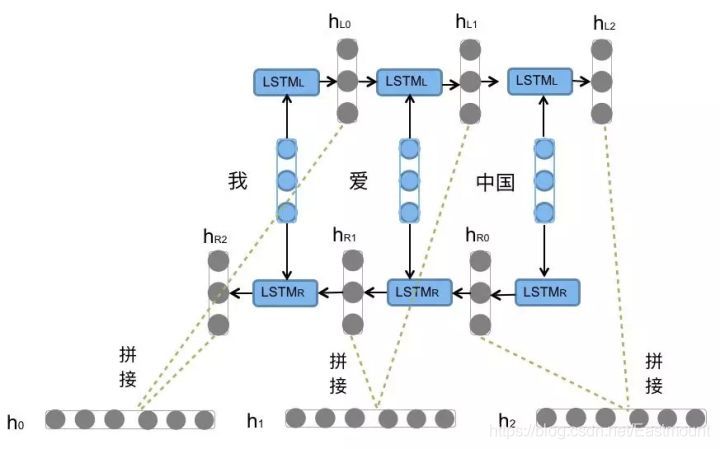
There is still a problem in using LSTM to model sentences: it is impossible to encode back to front information. In more fine-grained classification, such as the five classification tasks of strong commendatory meaning, weak commendatory meaning, neutral, weak derogatory meaning and strong derogatory meaning, we need to pay attention to the interaction between emotional words, degree words and negative words. For example, "this restaurant is not as dirty as the next door". The "no" here is a modification of the degree of "dirty". BiLSTM can better capture the two-way semantic dependence.
- Reference article: https://zhuanlan.zhihu.com/p/47802053
2. Code implementation
The BiLSTM code that Keras implements text classification is as follows:
- Keras_BiLSTM_cnews.py
""" Created on 2021-03-19 @author: xiuzhang Eastmount CSDN BiLSTM Model """ import os import time import pickle import pandas as pd import numpy as np from sklearn import metrics import matplotlib.pyplot as plt import seaborn as sns import tensorflow as tf from sklearn.preprocessing import LabelEncoder,OneHotEncoder from keras.models import Model from keras.layers import LSTM, Activation, Dense, Dropout, Input, Embedding from keras.layers import Convolution1D, MaxPool1D, Flatten from keras.preprocessing.text import Tokenizer from keras.preprocessing import sequence from keras.callbacks import EarlyStopping from keras.models import load_model from keras.models import Sequential #GPU accelerates CuDNNLSTM faster than LSTM from keras.layers import CuDNNLSTM, CuDNNGRU from keras.layers import Bidirectional ## If the GPU processing reader is a CPU, you can comment on this part of the code ## Specifies the maximum amount of video memory used in each GPU process 0.9 Indicates that it can be used GPU 90%Training with resources os.environ["CUDA_DEVICES_ORDER"] = "PCI_BUS_IS" os.environ["CUDA_VISIBLE_DEVICES"] = "0" gpu_options = tf.GPUOptions(per_process_gpu_memory_fraction=0.8) sess = tf.Session(config=tf.ConfigProto(gpu_options=gpu_options)) start = time.clock() #----------------------------Step 1 data reading---------------------------- ## Read test data set train_df = pd.read_csv("news_dataset_train_fc.csv") val_df = pd.read_csv("news_dataset_val_fc.csv") test_df = pd.read_csv("news_dataset_test_fc.csv") print(train_df.head()) ## Solve the problem of Chinese display plt.rcParams['font.sans-serif'] = ['KaiTi'] #Specifies the default font SimHei bold plt.rcParams['axes.unicode_minus'] = False #Solution: the saved image is a negative sign' #--------------------------Step 2 OneHotEncoder()code-------------------- ## Encode the label data of the dataset train_y = train_df.label val_y = val_df.label test_y = test_df.label print("Label:") print(train_y[:10]) le = LabelEncoder() train_y = le.fit_transform(train_y).reshape(-1,1) val_y = le.transform(val_y).reshape(-1,1) test_y = le.transform(test_y).reshape(-1,1) print("LabelEncoder") print(train_y[:10]) print(len(train_y)) ## Label data of the dataset-hot code ohe = OneHotEncoder() train_y = ohe.fit_transform(train_y).toarray() val_y = ohe.transform(val_y).toarray() test_y = ohe.transform(test_y).toarray() print("OneHotEncoder:") print(train_y[:10]) #-----------------------Step 3 use Tokenizer Encode phrases-------------------- max_words = 6000 max_len = 600 tok = Tokenizer(num_words=max_words) #The maximum number of words is 6000 print(train_df.cutword[:5]) print(type(train_df.cutword)) ## Prevent digital str processing in Corpus train_content = [str(a) for a in train_df.cutword.tolist()] val_content = [str(a) for a in val_df.cutword.tolist()] test_content = [str(a) for a in test_df.cutword.tolist()] tok.fit_on_texts(train_content) print(tok) ## Save the trained Tokenizer and import with open('tok.pickle', 'wb') as handle: #saving pickle.dump(tok, handle, protocol=pickle.HIGHEST_PROTOCOL) with open('tok.pickle', 'rb') as handle: #loading tok = pickle.load(handle) #---------------------------Step 4 convert data into sequence----------------------------- train_seq = tok.texts_to_sequences(train_content) val_seq = tok.texts_to_sequences(val_content) test_seq = tok.texts_to_sequences(test_content) ## Adjust each sequence to the same length train_seq_mat = sequence.pad_sequences(train_seq,maxlen=max_len) val_seq_mat = sequence.pad_sequences(val_seq,maxlen=max_len) test_seq_mat = sequence.pad_sequences(test_seq,maxlen=max_len) print("Data conversion sequence") print(train_seq_mat.shape) print(val_seq_mat.shape) print(test_seq_mat.shape) print(train_seq_mat[:2]) #-------------------------------Step 5 establish BiLSTM Model-------------------------- num_labels = 4 model = Sequential() model.add(Embedding(max_words+1, 128, input_length=max_len)) model.add(Bidirectional(CuDNNLSTM(128))) model.add(Dense(128, activation='relu')) model.add(Dropout(0.3)) model.add(Dense(num_labels, activation='softmax')) model.summary() model.compile(loss="categorical_crossentropy", optimizer='adam', # RMSprop() metrics=["accuracy"]) #-------------------------------Step 6 model training and prediction-------------------------- ## First set to train training and then set to test test flag = "train" if flag == "train": print("model training") ## Model training-loss Stop training when you no longer improve 0.0001 model_fit = model.fit(train_seq_mat, train_y, batch_size=128, epochs=10, validation_data=(val_seq_mat,val_y), callbacks=[EarlyStopping(monitor='val_loss',min_delta=0.0001)] ) model.save('my_model.h5') del model elapsed = (time.clock() - start) print("Time used:", elapsed) print(model_fit.history) else: print("model prediction ") ## Import the trained model model = load_model('my_model.h5') ## Predict the test set test_pre = model.predict(test_seq_mat) ## Evaluate the prediction effect and calculate the confusion matrix confm = metrics.confusion_matrix(np.argmax(test_y,axis=1),np.argmax(test_pre,axis=1)) print(confm) ## Confusion matrix visualization Labname = ["Sports", "Culture", "Finance and Economics", "game"] print(metrics.classification_report(np.argmax(test_y,axis=1),np.argmax(test_pre,axis=1))) plt.figure(figsize=(8,8)) sns.heatmap(confm.T, square=True, annot=True, fmt='d', cbar=False, linewidths=.6, cmap="YlGnBu") plt.xlabel('True label',size = 14) plt.ylabel('Predicted label', size = 14) plt.xticks(np.arange(4)+0.5, Labname, size = 12) plt.yticks(np.arange(4)+0.5, Labname, size = 12) plt.savefig('result.png') plt.show() #----------------------------------Seventh, verify the algorithm-------------------------- ## tok is used to preprocess the validation data set, and the trained model is used for prediction val_seq = tok.texts_to_sequences(val_df.cutword) ## Adjust each sequence to the same length val_seq_mat = sequence.pad_sequences(val_seq,maxlen=max_len) ## Predict validation set val_pre = model.predict(val_seq_mat) print(metrics.classification_report(np.argmax(val_y,axis=1),np.argmax(val_pre,axis=1))) elapsed = (time.clock() - start) print("Time used:", elapsed)
The training output model is shown below, and the GPU time is still very fast.
_________________________________________________________________ Layer (type) Output Shape Param # ================================================================= embedding_1 (Embedding) (None, 600, 128) 768128 _________________________________________________________________ bidirectional_1 (Bidirection (None, 256) 264192 _________________________________________________________________ dense_1 (Dense) (None, 128) 32896 _________________________________________________________________ dropout_1 (Dropout) (None, 128) 0 _________________________________________________________________ dense_2 (Dense) (None, 4) 516 ================================================================= Total params: 1,065,732 Trainable params: 1,065,732 Non-trainable params: 0 Train on 40000 samples, validate on 20000 samples Epoch 1/10 40000/40000 [==============================] - 23s 587us/step - loss: 0.5825 - acc: 0.8038 - val_loss: 0.2321 - val_acc: 0.9246 Epoch 2/10 40000/40000 [==============================] - 21s 521us/step - loss: 0.1433 - acc: 0.9542 - val_loss: 0.2422 - val_acc: 0.9228 Time used: 52.763230400000005
The prediction results are shown in the figure below:
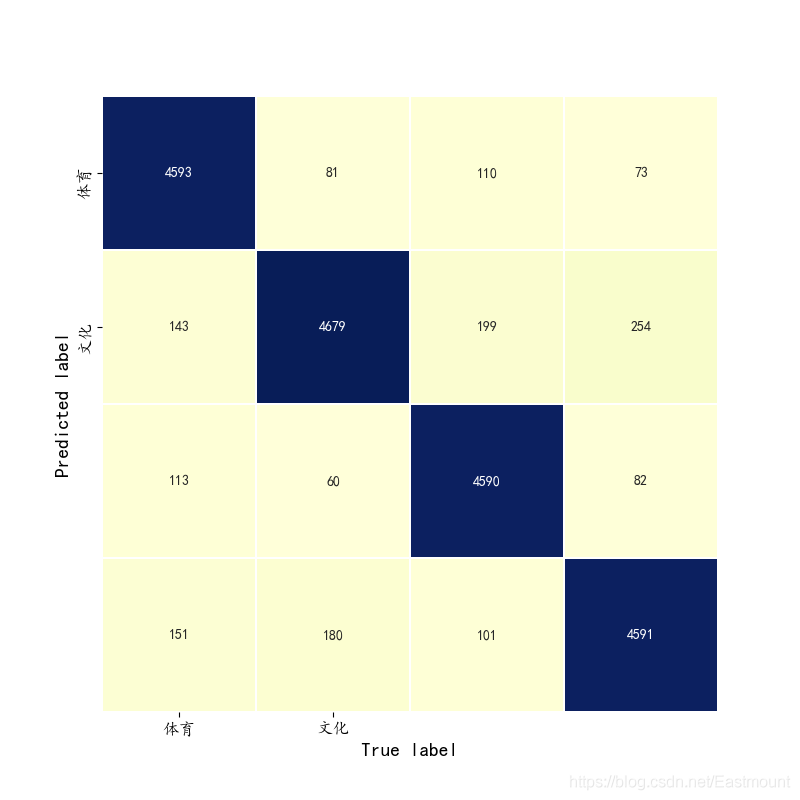
[[4593 143 113 151] [ 81 4679 60 180] [ 110 199 4590 101] [ 73 254 82 4591]] precision recall f1-score support 0 0.95 0.92 0.93 5000 1 0.89 0.94 0.91 5000 2 0.95 0.92 0.93 5000 3 0.91 0.92 0.92 5000 avg / total 0.92 0.92 0.92 20000 precision recall f1-score support 0 0.94 0.90 0.92 5000 1 0.89 0.95 0.92 5000 2 0.95 0.90 0.93 5000 3 0.91 0.94 0.93 5000 avg / total 0.92 0.92 0.92 20000
VII BiLSTM+Attention Chinese text classification
1. Principle introduction
Attention mechanism is a problem-solving method proposed by imitating human attention. In short, it is to quickly screen out high-value information from a large amount of information. It is mainly used to solve the problem that it is difficult to obtain the final reasonable vector representation when the input sequence of LSTM/RNN model is long. The method is to retain the intermediate result of LSTM, learn it with a new model, and associate it with the output, so as to achieve the purpose of information screening.
What is attention?
First, briefly describe what the attention mechanism is. I believe NLP students will not be unfamiliar with this mechanism. It can be said to shine in the paper "Attention is all you need". In the machine translation task, it helped the depth model greatly improve its performance and output the best state of art model at that time. Of course, in addition to the attention mechanism, the model also uses many useful trick s to help improve the performance of the model. However, it cannot be denied that the core of this model is attention.
Attention mechanism, also known as attention mechanism, is a technology that enables the model to focus on important information and fully learn and absorb. It is not a complete model, but a technology that can act on any sequence model.
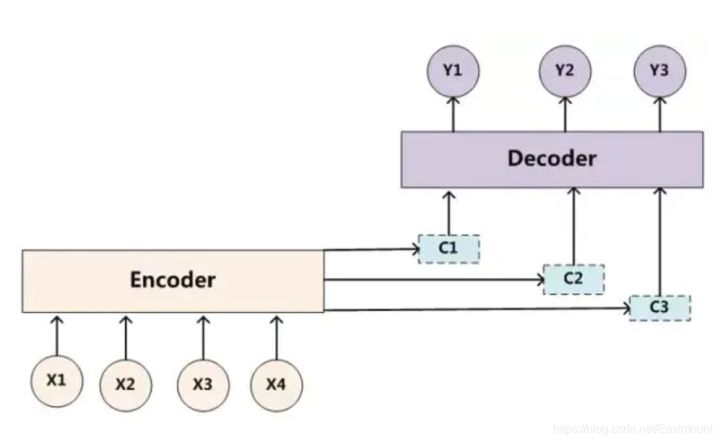
Why attention?
Why introduce the attention mechanism. For example, in the seq2seq model, for a text sequence, we usually use some mechanism to encode the sequence, encode it into a fixed length vector through dimension reduction and other methods, and input it to the subsequent full connection layer. Generally, we will use CNN or RNN (including GRU or LSTM) and other models to encode the sequence data, and then use various pooling or RNN to directly take the hidden state at the last t time as the vector output of the sentence.
However, there will be a problem here: conventional coding methods can not reflect the attention to different morphemes in a sentence sequence. In natural language, different parts of a sentence have different meanings and importance. For example, in the above example: I hate this movie If you do emotional analysis, it is obvious that you should pay more attention to the word hate. Of course, CNN and RNN can encode this information, but there is also an upper limit on this coding ability. For longer texts, the model effect will not be improved too much.
- Reference and recommended articles: https://zhuanlan.zhihu.com/p/46313756
Attention has a wide range of applications, including text and pictures.
- Text: applied to the seq2seq model. The most common application is translation
- Image: image extraction applied to convolutional neural network
- voice
The following figure is a classic BiLSTM+Attention model, which is also the model we need to establish next.
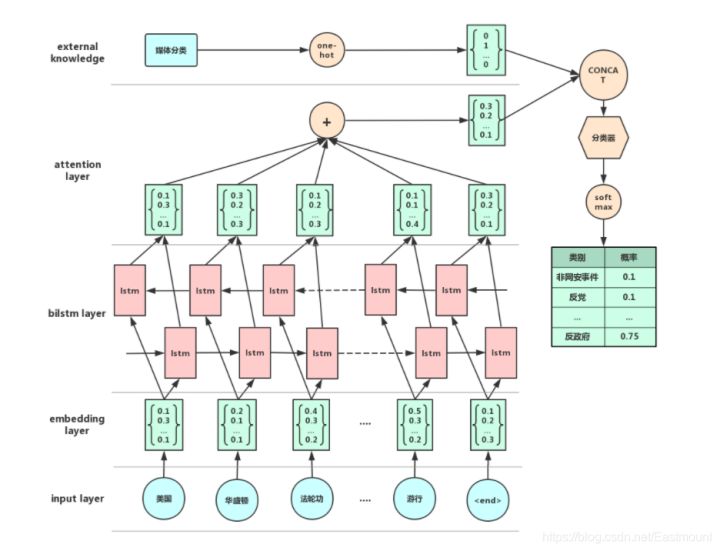
2. Code implementation
The BiLSTM+Attention code used by Keras to realize text classification is as follows:
- Keras_Attention_BiLSTM_cnews.py
""" Created on 2021-03-19 @author: xiuzhang Eastmount CSDN BiLSTM+Attention Model """ import os import time import pickle import pandas as pd import numpy as np from sklearn import metrics import matplotlib.pyplot as plt import seaborn as sns import tensorflow as tf from sklearn.preprocessing import LabelEncoder,OneHotEncoder from keras.models import Model from keras.layers import LSTM, Activation, Dense, Dropout, Input, Embedding from keras.layers import Convolution1D, MaxPool1D, Flatten from keras.preprocessing.text import Tokenizer from keras.preprocessing import sequence from keras.callbacks import EarlyStopping from keras.models import load_model from keras.models import Sequential #GPU accelerates CuDNNLSTM faster than LSTM from keras.layers import CuDNNLSTM, CuDNNGRU from keras.layers import Bidirectional ## If the GPU processing reader is a CPU, you can comment on this part of the code ## Specifies the maximum amount of video memory used in each GPU process 0.9 Indicates that it can be used GPU 90%Training with resources os.environ["CUDA_DEVICES_ORDER"] = "PCI_BUS_IS" os.environ["CUDA_VISIBLE_DEVICES"] = "0" gpu_options = tf.GPUOptions(per_process_gpu_memory_fraction=0.8) sess = tf.Session(config=tf.ConfigProto(gpu_options=gpu_options)) start = time.clock() #----------------------------Step 1 data reading---------------------------- ## Read test data set train_df = pd.read_csv("news_dataset_train_fc.csv") val_df = pd.read_csv("news_dataset_val_fc.csv") test_df = pd.read_csv("news_dataset_test_fc.csv") print(train_df.head()) ## Solve the problem of Chinese display plt.rcParams['font.sans-serif'] = ['KaiTi'] #Specifies the default font SimHei bold plt.rcParams['axes.unicode_minus'] = False #Solution: the saved image is a negative sign' #--------------------------Step 2 OneHotEncoder()code-------------------- ## Encode the label data of the dataset train_y = train_df.label val_y = val_df.label test_y = test_df.label print("Label:") print(train_y[:10]) le = LabelEncoder() train_y = le.fit_transform(train_y).reshape(-1,1) val_y = le.transform(val_y).reshape(-1,1) test_y = le.transform(test_y).reshape(-1,1) print("LabelEncoder") print(train_y[:10]) print(len(train_y)) ## Label data of the dataset-hot code ohe = OneHotEncoder() train_y = ohe.fit_transform(train_y).toarray() val_y = ohe.transform(val_y).toarray() test_y = ohe.transform(test_y).toarray() print("OneHotEncoder:") print(train_y[:10]) #-----------------------Step 3 use Tokenizer Encode phrases-------------------- max_words = 6000 max_len = 600 tok = Tokenizer(num_words=max_words) #The maximum number of words is 6000 print(train_df.cutword[:5]) print(type(train_df.cutword)) ## Prevent digital str processing in Corpus train_content = [str(a) for a in train_df.cutword.tolist()] val_content = [str(a) for a in val_df.cutword.tolist()] test_content = [str(a) for a in test_df.cutword.tolist()] tok.fit_on_texts(train_content) print(tok) ## Save the trained Tokenizer and import with open('tok.pickle', 'wb') as handle: #saving pickle.dump(tok, handle, protocol=pickle.HIGHEST_PROTOCOL) with open('tok.pickle', 'rb') as handle: #loading tok = pickle.load(handle) #---------------------------Step 4 convert data into sequence----------------------------- train_seq = tok.texts_to_sequences(train_content) val_seq = tok.texts_to_sequences(val_content) test_seq = tok.texts_to_sequences(test_content) ## Adjust each sequence to the same length train_seq_mat = sequence.pad_sequences(train_seq,maxlen=max_len) val_seq_mat = sequence.pad_sequences(val_seq,maxlen=max_len) test_seq_mat = sequence.pad_sequences(test_seq,maxlen=max_len) print("Data conversion sequence") print(train_seq_mat.shape) print(val_seq_mat.shape) print(test_seq_mat.shape) print(train_seq_mat[:2]) #---------------------------Step 5 establish Attention mechanism---------------------- """ because Keras There is no ready-made Attention Layer can be used directly. We need to build a new layer function ourselves. Keras The user-defined function is mainly divided into four parts: init: Initialize some required parameters bulid: How to define the weight call: The core part defines how vectors operate compute_output_shape: Defines the size of the layer's output Recommended articles: https://blog.csdn.net/huanghaocs/article/details/95752379 https://zhuanlan.zhihu.com/p/29201491 """ # Hierarchical Model with Attention from keras import initializers from keras import constraints from keras import activations from keras import regularizers from keras import backend as K from keras.engine.topology import Layer K.clear_session() class AttentionLayer(Layer): def __init__(self, attention_size=None, **kwargs): self.attention_size = attention_size super(AttentionLayer, self).__init__(**kwargs) def get_config(self): config = super().get_config() config['attention_size'] = self.attention_size return config def build(self, input_shape): assert len(input_shape) == 3 self.time_steps = input_shape[1] hidden_size = input_shape[2] if self.attention_size is None: self.attention_size = hidden_size self.W = self.add_weight(name='att_weight', shape=(hidden_size, self.attention_size), initializer='uniform', trainable=True) self.b = self.add_weight(name='att_bias', shape=(self.attention_size,), initializer='uniform', trainable=True) self.V = self.add_weight(name='att_var', shape=(self.attention_size,), initializer='uniform', trainable=True) super(AttentionLayer, self).build(input_shape) def call(self, inputs): self.V = K.reshape(self.V, (-1, 1)) H = K.tanh(K.dot(inputs, self.W) + self.b) score = K.softmax(K.dot(H, self.V), axis=1) outputs = K.sum(score * inputs, axis=1) return outputs def compute_output_shape(self, input_shape): return input_shape[0], input_shape[2] #-------------------------------Step 6 establish BiLSTM Model-------------------------- ## Defining the BiLSTM model ## BiLSTM+Attention num_labels = 4 inputs = Input(name='inputs',shape=[max_len],dtype='float64') layer = Embedding(max_words+1, 256, input_length=max_len)(inputs) #lstm = Bidirectional(LSTM(100, dropout=0.2, recurrent_dropout=0.1, return_sequences=True))(layer) bilstm = Bidirectional(CuDNNLSTM(128, return_sequences=True))(layer) #Parameter hold dimension 3 layer = Dense(128, activation='relu')(bilstm) layer = Dropout(0.2)(layer) ## Attention mechanism attention = AttentionLayer(attention_size=50)(layer) output = Dense(num_labels, activation='softmax')(attention) model = Model(inputs=inputs, outputs=output) model.summary() model.compile(loss="categorical_crossentropy", optimizer='adam', # RMSprop() metrics=["accuracy"]) #-------------------------------Step 7 model training and prediction-------------------------- ## First set to train training and then set to test test flag = "test" if flag == "train": print("model training") ## Model training-loss Stop training when you no longer improve 0.0001 model_fit = model.fit(train_seq_mat, train_y, batch_size=128, epochs=10, validation_data=(val_seq_mat,val_y), callbacks=[EarlyStopping(monitor='val_loss',min_delta=0.0001)] ) ## Save model model.save('my_model.h5') del model # deletes the existing model ## computing time elapsed = (time.clock() - start) print("Time used:", elapsed) print(model_fit.history) else: print("model prediction ") ## Import the trained model model = load_model('my_model.h5', custom_objects={'AttentionLayer': AttentionLayer(50)}, compile=False) ## Predict the test set test_pre = model.predict(test_seq_mat) ## Evaluate the prediction effect and calculate the confusion matrix confm = metrics.confusion_matrix(np.argmax(test_y,axis=1),np.argmax(test_pre,axis=1)) print(confm) ## Confusion matrix visualization Labname = ["Sports", "Culture", "Finance and Economics", "game"] print(metrics.classification_report(np.argmax(test_y,axis=1),np.argmax(test_pre,axis=1))) plt.figure(figsize=(8,8)) sns.heatmap(confm.T, square=True, annot=True, fmt='d', cbar=False, linewidths=.6, cmap="YlGnBu") plt.xlabel('True label',size = 14) plt.ylabel('Predicted label', size = 14) plt.xticks(np.arange(4)+0.5, Labname, size = 12) plt.yticks(np.arange(4)+0.5, Labname, size = 12) plt.savefig('result.png') plt.show() #----------------------------------Seventh, verify the algorithm-------------------------- ## tok is used to preprocess the validation data set, and the trained model is used for prediction val_seq = tok.texts_to_sequences(val_df.cutword) ## Adjust each sequence to the same length val_seq_mat = sequence.pad_sequences(val_seq,maxlen=max_len) ## Predict validation set val_pre = model.predict(val_seq_mat) print(metrics.classification_report(np.argmax(val_y,axis=1),np.argmax(val_pre,axis=1))) ## computing time elapsed = (time.clock() - start) print("Time used:", elapsed)
The training output model is as follows:
_________________________________________________________________ Layer (type) Output Shape Param # ================================================================= inputs (InputLayer) (None, 600) 0 _________________________________________________________________ embedding_1 (Embedding) (None, 600, 256) 1536256 _________________________________________________________________ bidirectional_1 (Bidirection (None, 600, 256) 395264 _________________________________________________________________ dense_1 (Dense) (None, 600, 128) 32896 _________________________________________________________________ dropout_1 (Dropout) (None, 600, 128) 0 _________________________________________________________________ attention_layer_1 (Attention (None, 128) 6500 _________________________________________________________________ dense_2 (Dense) (None, 4) 516 ================================================================= Total params: 1,971,432 Trainable params: 1,971,432 Non-trainable params: 0
The prediction results are shown in the figure below:
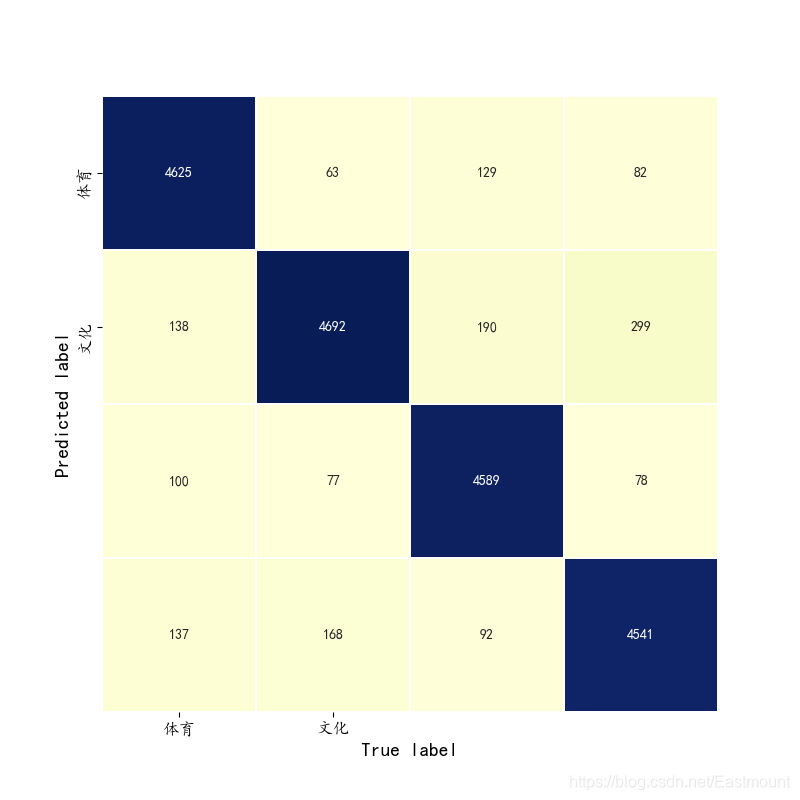
[[4625 138 100 137] [ 63 4692 77 168] [ 129 190 4589 92] [ 82 299 78 4541]] precision recall f1-score support 0 0.94 0.93 0.93 5000 1 0.88 0.94 0.91 5000 2 0.95 0.92 0.93 5000 3 0.92 0.91 0.91 5000 avg / total 0.92 0.92 0.92 20000 precision recall f1-score support 0 0.95 0.91 0.93 5000 1 0.88 0.95 0.91 5000 2 0.95 0.90 0.92 5000 3 0.92 0.93 0.93 5000 avg / total 0.92 0.92 0.92 20000
Click focus to learn about Huawei cloud's new technologies for the first time~